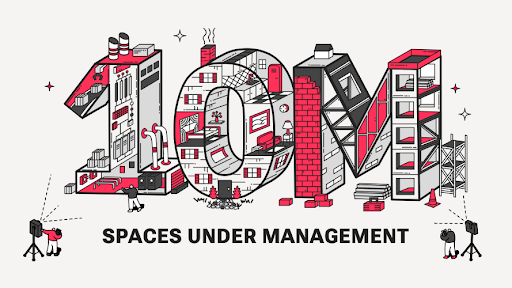10 Million Reasons to Celebrate
Matterport’s massive spatial data set exceeds 10 million Spaces Under Management, accelerating AI innovation and the future of digital twins

We recently reached an exciting milestone at Matterport as we surpassed 10 million Spaces Under Management (SUM) with over 30 billion square feet of physical space captured. To put some context to those big numbers - that’s nearly 1,100 square miles of the built world digitized, roughly equal to Los Angeles (502 sq. mi.) and London (607 sq. mi.) combined!
Matterport digital twins have been explored by millions of people around the world, connecting people through immersive experiences previously unimaginable. While Matterport is widely known for providing a window into the home-buying process, our platform's ongoing evolution has enabled us to solve big customer challenges across a range of industries, including real estate, construction, manufacturing, retail, travel, and hospitality. Matterport's defining characteristic is the diversity of the buildings and spaces we capture, which includes factories, construction sites, historic landmarks, museums, highrises, hotels, retail locations, and of course homes, apartments, and more - the list is truly unlimited.
A Matterport digital twin has evolved into so much more than the powerful property marketing engine for which it has become the industry standard. Today, it enables remote facilities management, virtual inspections, and online collaboration from anywhere in the world. Companies small and large, including the Fortune 1000 are turning to Matterport for innovative, industrial-strength solutions for space planning, quality management, and progress monitoring, across multiple facilities to help reduce costs while extracting deeper insights about their properties throughout every stage of the building lifecycle.
That’s why companies like John Deere have chosen Matterport to virtualize their global manufacturing facilities, why AWS is partnering with us to deliver real-time insights within our digital twins used to support manufacturing processes to their customers, and why industry stalwarts like Autodesk are working with us to redefine how faster collaboration can be achieved in the construction sector.
The widespread adoption of Matterport digital twins across verticals and around the globe has fueled our growth- more than doubling the number of spaces captured in just two years. This milestone only further unlocks the value that we can create for our customers because as our spatial data library grows, our software gets even smarter.
Our digital twin platform is powered by Cortex AI - a deep learning neural network that uses advanced machine learning to fully automate precision 3D reconstruction of any physical space captured. Cortex has been designed to scale with the rapid global adoption of Matterport digital twins, and deliver the most cost-effective solution on the market today. No other company offers a fully automated solution that scales so effortlessly in terms of both square footage, and time and cost to produce. And as discussed, our digital twins go far beyond the magic of immersive exploration to provide the commercial strength our customers require for business critical daily operations and automation across a host of industries.
The industry at large has reached a turning point, where the rising demand for efficiency and automation, driven by innovation such as AI in digital transformation, has given Matterport a clear market advantage. Matterport is focused on providing scalable AI services specifically for buildings and spaces, and we’re already delivering on breakthrough features that leverage our vast library of spatial data. Services like Property Intelligence can transform digital twins into business-critical insights at scale, such as assessing the quality of appliances and countertops, the number of south-facing windows, or whether a building meets accessibility standards. Property Intelligence trains and learns from billions of 3D data points to deliver new insights previously inaccessible to customers and their spaces.
Our digital twins are also sustainability in action. By turning millions of buildings and other physical spaces into 3D digital twins, we empower people across the world to work in smarter ways that put less strain on the planet. In 2021 alone, Matterport digital twins have resulted in an estimated 374,312 fewer tonnes of carbon dioxide equivalent from being emitted through reduced business travel.1 As our platform continues to evolve and mature, Matterport’s digital twins are increasingly becoming an integral part of our customers’ sustainability strategies.
So what’s next? We continue our mission to digitize the built world - 10 million SUM is just the start and with an estimated four billion buildings in the world, we have a sizable opportunity in front of us! We’re focused on the science of building the best digital twins in the industry, advancing our data science, and scaling our data library.
Leading an industry transformation of this magnitude is, without a doubt, incredibly hard work. Matterport created this category more than a decade ago, and we’ll boldly lead the industry through the next decade of digitization and datafication of the built world. At Matterport, we’re inspired by our vision to fundamentally improve the way people understand and interact with the physical world while making every space more valuable and accessible. It’s hard not to love what we do here at Matterport - here’s to the next 10 million spaces and beyond!
Forward-Looking Statements
This post contains certain forward-looking statements within the meaning of the federal securities laws. Many factors could cause actual future events to differ materially from the forward-looking statements in this post, including the expected benefits of Matterport’s partnerships and the impacts of Matterport’s sustainability efforts, and Matterport’s ability to implement business plans, forecasts, and other expectations in the industry in which Matterport competes, and to identify and realize additional opportunities. You should carefully consider the risks and uncertainties described in documents filed by Matterport from time to time with the U.S. Securities and Exchange Commission.
1Source: Matterport followed best-practice guidance from the World Resources Institute and GHG Protocol when calculating the avoided emissions. A consequential estimation approach was applied and results were calibrated based on a conservative approach.
